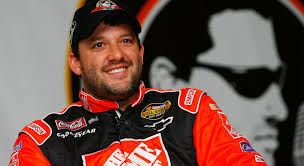In the fast-paced world of motorsports, there are drivers who win races and then there are those who change the game entirely. Tony Stewart is one of the rare few who did both. Known for his fierce competitiveness, raw talent, and unfiltered personality, Stewart became one of the most iconic figures in American racing history. From humble dirt tracks in Indiana to the glitz and pressure of NASCAR’s biggest stages, Stewart’s journey is not just about trophies it’s about transformation.
Early Roots: From Go-Karts to Glory
Tony Stewart’s racing story began like many greats behind the wheel of a go-kart. Born in Columbus, Indiana in 1971, Stewart quickly made a name for himself on the regional racing scene. His rise through the ranks was meteoric, moving from karting to open-wheel cars, and eventually dominating in USAC (United States Auto Club) competitions. He became the first driver in history to win USAC’s Triple Crown national midget, sprint, and Silver Crown championships in a single season (1995). That versatility would become a defining feature of his career.
By 1997, Stewart had claimed the Indy Racing League (IRL) championship, showcasing his talent on high-speed oval tracks. But he was just getting started.
The NASCAR Breakthrough
Stewart transitioned to NASCAR in 1999 with Joe Gibbs Racing. Almost immediately, he showed he belonged among the sport’s elite. He won three races as a rookie a rare feat and continued to build a reputation as one of the most aggressive and determined drivers in the garage.
His first NASCAR Cup Series championship came in 2002, followed by two more titles in 2005 and 2011. The 2011 title, in particular, was legendary Stewart won five of the final ten races in the playoffs and clinched the championship in a tiebreaker against Carl Edwards. It was a drive that perfectly embodied who Tony Stewart was: relentless, fearless, and unwilling to back down.
A True Throwback: Racing Anything, Anywhere
While many modern drivers stick strictly to their NASCAR schedule, Stewart stayed connected to his roots. He continued to race sprint cars and midgets in local events not for money or fame, but out of pure love for the sport. His willingness to race anything with four wheels earned respect from fans and fellow drivers alike.
This passion led him to purchase Eldora Speedway, a legendary dirt track in Ohio, and introduce high-profile events like the “Eldora Dirt Derby,” which brought NASCAR Truck Series racing to a dirt track for the first time in decades.
Through his promotion and ownership of local tracks, Stewart became a bridge between the grassroots racing scene and the top levels of motorsports. He championed the idea that the heart of racing lives in small towns and weekend tracks not just corporate sponsorships and national broadcasts.
Owner-Driver: A Rare Champion
In 2009, Tony Stewart made a bold move that few believed could succeed in the modern NASCAR era: he became a team owner. He partnered with Gene Haas to form Stewart-Haas Racing (SHR) and, in doing so, became the first driver-owner to win a NASCAR Cup Series title since Alan Kulwicki in 1992.
Stewart’s 2011 championship as an owner-driver was more than a personal milestone it was a shot in the arm for independent racers and underdog teams. He proved that passion, leadership, and talent could still overcome massive financial and technological disadvantages.
Under his leadership, Stewart-Haas Racing would go on to field championship-caliber cars for multiple drivers, including Kevin Harvick, who won the 2014 title. Stewart transitioned into a leadership and mentorship role, helping shape the next generation of talent.
Controversy and Complexity
Tony Stewart’s legacy isn’t without controversy. His fiery temper led to run-ins with competitors, officials, and the media throughout his career. He was known to throw helmets, deliver harsh post-race interviews, and openly criticize NASCAR leadership.
In 2014, Stewart was involved in a tragic sprint car accident that led to the death of fellow driver Kevin Ward Jr. Though no criminal charges were filed and it was ruled an accident, the incident cast a long shadow over his career and deeply affected him personally and professionally. Stewart took a hiatus from racing and spoke publicly about the emotional toll.
Rather than retire or fade away, Stewart returned with the same drive and passion. His later years in NASCAR were marked by resilience, maturity, and a greater appreciation for his role as a steward of the sport.
Lasting Legacy
Tony Stewart retired from full-time NASCAR competition in 2016, but his influence on the sport has only grown. He was inducted into the NASCAR Hall of Fame in 2020, a fitting recognition for a driver who defined an era.
Today, he remains active in motorsports through ownership, broadcasting, and his latest venture the launch of the SRX (Superstar Racing Experience) series, which he co-founded. SRX features short-track racing with legendary drivers in identical cars, bringing back a sense of competition and spectacle that many fans felt was missing.
The Icon Who Never Played It Safe
Tony Stewart is more than just a racing champion he’s a cultural icon in motorsports. He brought personality, edge, and a raw, unfiltered love for racing to the highest levels of the sport. He didn’t fit the mold of the polished, sponsor-friendly driver. And that’s exactly why he changed the game.
Stewart proved that greatness doesn’t come from perfection it comes from passion, persistence, and the courage to do things your own way.

